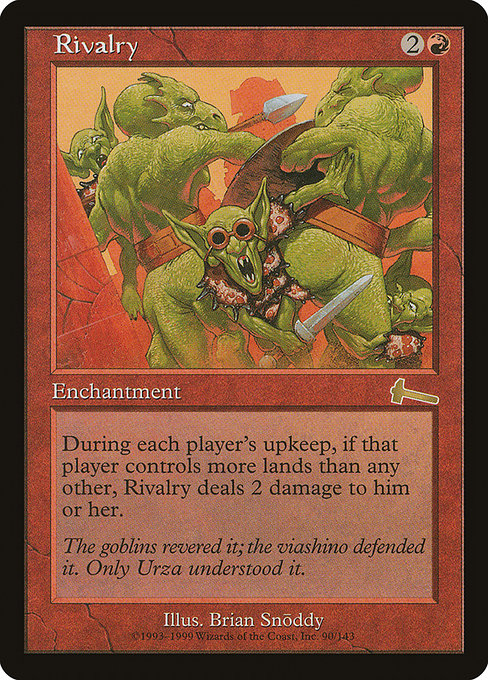
Image courtesy of Scryfall.com
Power, Pressure, and the Enchantment of Equilibrium
Magic: The Gathering often measures "power" through creature stats, but Rivalry proves that a card's influence can be just as potent without a single power/toughness line. This red enchantment from Urza's Legacy turns the board into a quiet scoreboard, counting lands and doling out 2 damage to the leader on each upkeep if they have the most lands. The effect is simple on the surface, but its implications ripple through tempo, resource management, and player psychology. 🧙♂️🔥
With a mana cost of 2R, Rivalry sits squarely in red's wheelhouse: aggressive, fast, and capable of punishing mistakes with a quick strike. The rarity is rare, signaling a design that would have called for careful deck-building and precise play. In the text, "At the beginning of each player's upkeep, if that player controls more lands than each other player, this enchantment deals 2 damage to them." The rules text is compact, but the strategic resonance is large: if you ramp ahead, you will take damage, and that damage scales with the tempo you create. The tension is quintessentially MTG—risk and reward living on the same page. ⚔️
That tension mirrors the broader concept of Power/Toughness in non-creature cards: you might not see a creature with P/T, but you still see a measure of threat—how quickly a card can press the board, wear down life totals, or force opponents to alter their plans. Rivalry’s "ratio" is about who can hold the lead responsibly. Each upkeep is a new calculation: Do I want to push further into lands, or am I prepared to absorb the burn if I stay ahead? This dynamic becomes more pronounced in multiplayer where you’re balancing diplomacy, denial, and inevitability. The result is a game state that rewards precise timing and a keen eye on the mana curve. The ongoing burn can become a subtle equalizer, shifting momentum without ever touching the combat step. 🧲
In practical terms, Rivalry rewards tempo and planning. If you’re the ramp-heavy player who reaches a healthy mountain of lands, Rivalry's upkeep damage accelerates a race against the clock. If you prefer a more controlled pace, you can use Rivalry to nudge opponents toward diversified mana sources instead of over-ramping. In two-player formats, the effect is brutally honest: if you’re ahead on lands, you’re taking 2 damage each turn. This creates a compelling trade-off: you can ramp, but you’re inviting incremental pressure that could tilt the game if your life total or burn spells aren’t ready to withstand it. ⚡🔥
The lore makes it even richer. The flavor text — "The goblins revered it; the viashino defended it. Only Urza understood it." — hints at a world where powerful artifacts, cunning ecosystems, and master planners coexist in fragile equilibrium. Rivalry’s art—credited to Brian Snõddy—captures that era's intensity, with sharp contrasts and a sense of imminent clash. It’s more than a card; it’s a vignette from a time when players debated how much risk was worth the reward, and whether a single enchantment could steer a game’s fate. 🎨
Collectors appreciate Rivalry as a rare that slides into decks looking for vintage relevance or quirky, thematic spice. While not a centerpiece staple, it’s the sort of card that sparkles at casual tables and becomes a talking point among long-time players who remember Urza's Legacy with fondness. Its price points reflect its rarity and the enduring charm of 1999-era design. For those chasing foil versions, a bit more value appears in the modern market, but the core card remains accessible for most reprint-era collections. 💎
Key takeaways
- Rivalry costs 2R and is an enchantment that punishes the lead in lands by dealing 2 damage at upkeep.
- In 1v1, it punishes the player who ramps the most; in multiplayer, it creates shifting alliances and tactical play around mana development.
- The card exemplifies red’s tempo-oriented playstyle and the era-specific design philosophy of Urza’s Legacy.
- The flavor text and art reinforce a theme of contested balance—an artifact that’s revered, defended, and understood by a singular mind in Urza.
- Collectibility and price reflect its rarity and nostalgic value within vintage MTG circles.
More from our network
- https://blog.rusty-articles.xyz/blog/post/thoughtful-design-transforms-everyday-routines-with-non-slip-neon-gaming-mouse-pad/
- https://crypto-acolytes.xyz/blog/post/nft-stats-gorbagio-4270-from-gorbagio-collection/
- https://blog.crypto-articles.xyz/blog/post/nft-data-planet-kaiju-587-from-planet-kaiju-collection-on-magiceden/
- https://articles.zero-static.xyz/blog/post/un-sets-color-balance-metrics-for-golgothian-sylex/
- https://articles.zero-static.xyz/blog/post/did-the-hype-for-civilization-v-live-up-to-expectations/

Rivalry
At the beginning of each player's upkeep, if that player controls more lands than each other player, this enchantment deals 2 damage to them.
ID: 3b79677b-d5b9-47c7-a5f5-45446d5cddff
Oracle ID: da77cf1b-eaeb-4a60-aa16-a1217ce8b550
Multiverse IDs: 8903
TCGPlayer ID: 6379
Cardmarket ID: 10647
Colors: R
Color Identity: R
Keywords:
Rarity: Rare
Released: 1999-02-15
Artist: Brian Snõddy
Frame: 1997
Border: black
EDHRec Rank: 23644
Penny Rank: 6158
Set: Urza's Legacy (ulg)
Collector #: 90
Legalities
- Standard — not_legal
- Future — not_legal
- Historic — not_legal
- Timeless — not_legal
- Gladiator — not_legal
- Pioneer — not_legal
- Modern — not_legal
- Legacy — legal
- Pauper — not_legal
- Vintage — legal
- Penny — legal
- Commander — legal
- Oathbreaker — legal
- Standardbrawl — not_legal
- Brawl — not_legal
- Alchemy — not_legal
- Paupercommander — not_legal
- Duel — legal
- Oldschool — not_legal
- Premodern — legal
- Predh — legal
Prices
- USD: 0.38
- USD_FOIL: 2.75
- EUR: 0.27
- EUR_FOIL: 3.58
- TIX: 0.02
More from our network
- https://blog.digital-vault.xyz/blog/post/from-pen-to-pixel-the-future-of-digital-stationery-and-paper-crafting/
- https://crypto-acolytes.xyz/blog/post/pfp-on-solana-meme-coin-faces-risk-as-momentum-falls/
- https://crypto-acolytes.xyz/blog/post/nft-stats-buly-582-from-buly-collection/
- https://crypto-acolytes.xyz/blog/post/red-hued-furnace-bright-giant-in-ara-illuminates-3d-milky-way-mapping/
- https://wiki.digital-vault.xyz/wiki/post/pokemon-tcg-stats-flying-pikachu-card-id-pl2-113/
